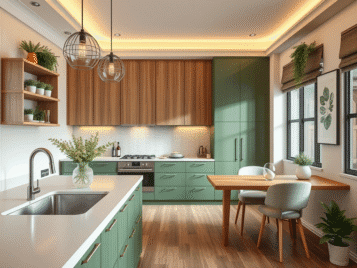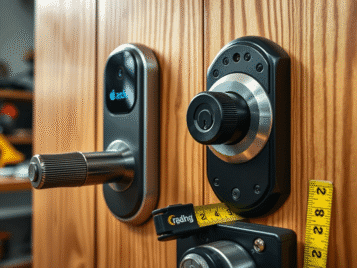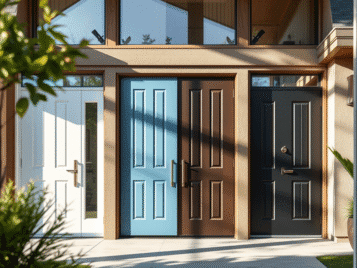Glass towers aren’t the only things competing for skyline attention. The cladding you choose—whether aluminium composite panel or exterior‑grade compact HPL—decides how your building will age, how often you’ll scale the scaffold, and how confidently you’ll sleep when the fire inspector arrives. This deep dive separates marketing hype from measurable performance, using verified test standards and field data. No brand names beyond SamratHPL appear, so you can focus squarely on the material science.
1. What Exactly Are We Comparing?
| Property | ACP (Aluminium Composite Panel) | Compact HPL (High‑Pressure Laminate) |
|---|---|---|
| Core makeup | 0.25–0.5 mm aluminium skins bonded to polymer core (PE, FR, or mineral) | Solid phenolic core formed under high heat and pressure; decorative layers on both faces |
| Typical thickness | 3–4 mm overall | 6–8 mm (self‑supporting) |
| Self‑supporting? | Needs sub‑framing every 600 mm | Can span up to 900 mm without sag |
| Standard fire class options | Up to Class B‑s1,d0 when mineral‑filled | Class B‑s1,d0 standard; Class A arrays available |
| UV topcoat | Polyester or PVDF paints | Double‑hardened acrylic‑PU overlay |
2. Durability & Weathering
Accelerated Weather Tests
- ACP coatings typically pass 2 000–3 000 hours of QUV exposure before ΔE > 5 colour change.
- Compact HPL panels with UV‑cured overlays routinely exceed 3 500 hours before similar fade appears.
Real‑World Observations
- Coastal projects in Spain reported salt creep behind poorly sealed ACP joints within five years.
- HPL façades in humid Kerala logged surface chalking under 1 % at the ten‑year maintenance review—well below repaint thresholds.
Bottom line: HPL’s solid core and thicker UV barrier deliver a longer colour‑fast life, especially in salty or humid atmospheres.
3. Fire Safety Matters—Everywhere
New regulations in the EU, UK, Australia, and parts of India restrict combustible PE‑core ACP on mid‑rise and high‑rise buildings. Even “FR‑core” ACP relies on mineral fillers dispersed in a polymer matrix; it meets Class B‑s1,d0 only if installation leaves full ventilation behind the panel.
Compact HPL, by contrast, achieves the same Class B‑s1,d0 rating in a single, inorganic‑rich core—no melting polymer layer, no aluminium skin to delaminate. SamratHPL’s exterior range is certified to EN 13501‑1 and carries third‑party reports for easy code submission in Europe and India alike.
4. Impact & Dent Resistance
| Test | ACP | Compact HPL |
|---|---|---|
| Soft‑body impact (spring bag, 10 J) | Visible skin dent, possible core shear | No visible dent, minor surface mar |
| Hail resistance (ice ball 25 mm, 80 km/h) | 15 % panel dent rate | 0 % dent; surface micro‑abrasion only |
Aluminium’s ductility lends ACP some flex, but permanent dimples form under moderate impact. HPL’s dense resin core distributes energy, keeping the façade smooth after storms or wayward cricket balls.
5. Installation & Maintenance
ACP
- Lightweight sheets mean quick hoist times.
- Panels must be folded or riveted into cassettes‑–adds labour.
- Silicone joints need annual inspection to stop water tracking behind skins.
Compact HPL
- Heavier, yet self‑supporting: fewer sub‑framing rails.
- Panels factory‑pre‑routed for concealed fasteners, speeding on‑site fit.
- Joints ventilate naturally; surface cleans with neutral soap, no repaint cycles.
6. Cost Snapshot (mid‑2025)
| Region | ACP basic (FR‑core) | Compact HPL (6 mm) |
|---|---|---|
| India (₹/sq ft) | 220–260 | 310–360 |
| Germany (€/m²) | 70–85 | 100–120 |
| Spain (€/m²) | 65–80 | 95–115 |
Installation can equal 35–50 % of panel cost. HPL often wins back its premium via reduced sub‑framing and zero repaint budgets over twenty years.
7. Sustainability & End‑of‑Life
- Recyclability – ACP must be shredded and separated; few plants handle mixed metal–polymer waste. Compact HPL can be milled into Refuse‑Derived Fuel (RDF) or reused as street‑furniture cladding.
- Embodied carbon – Aluminium smelting is energy‑intensive. HPL uses paper layers and phenolic resin; its CO₂ footprint per square metre is typically 25–35 % lower than ACP.
- Circular economy – SamratHPL offers take‑back pallets; cut‑offs re‑enter the RDF stream, supporting waste‑to‑energy plants in Europe.
8. When Does ACP Still Make Sense?
- Short‑cycle retail fronts where a facelift is planned every 5–7 years.
- Lightweight retrofits on load‑limited structures, provided fire code allows FR‑core use.
- Budget‑driven projects in dry inland climates with minimal salt attack and where Class B is not mandated.
9. Decision Matrix
| Priority | Recommended choice |
|---|---|
| 20‑year colour stability | Compact HPL |
| Lowest initial cost | ACP |
| Coastal or high‑UV site | Compact HPL |
| Strict fire regulations | Compact HPL |
| Rapid installation on low‑rise | ACP |
Final Word
A façade is your building’s first and hardest‑working suit of armour. If you are balancing long‑term durability, fire safety, and lifecycle cost, exterior‑grade compact HPL from SamratHPL stands ahead. Aluminium composite panels retain a place for shorter‑term, cost‑sensitive builds, but their polymer cores and dent‑prone skins limit life expectancy and code flexibility.
Before signing off on specifications—whether you’re detailing a hospital in Hamburg, an IT hub in Hyderabad, or a seaside resort in Málaga—match the cladding to your climate, compliance needs, and maintenance appetite. The choice you make today will echo for decades on every sunny afternoon, rainy monsoon, and chilly winter your building faces.



